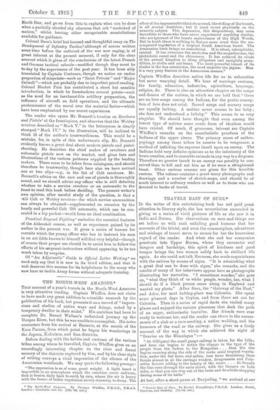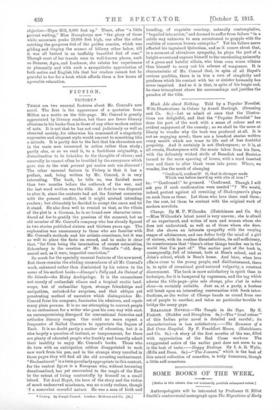TRAVELS EAST OF SUEZ.* Ir the writer of this entertaining
book has not paid great attention to literary style, she has nevertheless succeeded in giving us a series of vivid pictures of life as she saw it in India and Burma. Her observations on men and things are set before us with such unfailing good humour that her accounts of the trivial, and even the commonplace, adventures and mishaps of travel serve to secure for her the benevolent regard of the reader. And when she and her companion penetrate into Upper Burma, where they encounter real dangers and hardships, this spirit of kindness and good temper brings the two women safely back to civilized life again. As she could not talk Burmese, she made acquaintance with the natives by means of signs. "It is astonishing what a great deal can be done with signs," she remarks, and the results of many of her interviews appear here as photographs illustrating her narrative. "I sometimes wonder," she goes on, "what they think of us white people, wonder, too, what I should do if a black person came along in England and wanted my photo." After Suez, the "Gateway of the East," and Aden, her next halting-place was Colombo. She spent some pleasant days in Ceylon, and from there set out for Calcutta. Then in a series of rapid darts she visited many places and enjoyed the various pleasures that deck the path of an eager, enthusiastic traveller. Her friends were ever ready to welcome her, and the reader can share in the amuse- ments of a dub or a race-meeting, a native wedding, and the humours of the road or the railway. She gives us a lively account of the way in which she achieved the sight of "Sunrise on the Himalayas " " At Gilligurri the small gauge railway is taken for the hills; and here one begins to notice the change in the type of the people from the Indian to the Mongolian . . . then the rise begins running along the side of the rooks amid tropical vegeta- tion under the Sal trees, and palms, tree ferns flourishing their fronds almost in at the carriage window, Brugmansia and Poin- settia flowers adding to the beauty of the scone. . . . At Sounda the line runs through the main street, with the bazaars on both sides, so that you can step out of the train and do a little shopping during some of its halts."
At last, after a short pause at Derjeeling, "we arrived at our * Travois East of gum By Rachel Humphreys, F.R.G.S. London : Beath, Crauton, and Ouseley. fn. 641. net.]
objective—Tiger Hill, 9,000 feet up." There, after "a little patient waiting," Miss Humphreys saw "the glory of those while mountain peaks 29,000 feet high, one after the other catching the gorgeous tint of the golden sunrise, which was gilding and tinging the masses of billowy ether below, till it was all bathed in an ineffably beautiful tint of rose." Though most of her travels were to well-known places, such as Benares, Agra, and Lucknow, she relates her experiences so pleasantly and with such a sympathetic appreciation of both native and English life that her readers cannot but be grateful to her for a book which affords them a few hours of agreeable relaxation.















































 Previous page
Previous page